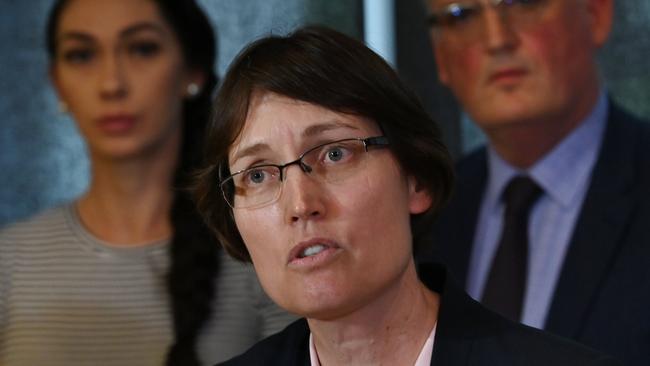Shandee’s Story: Lab’s DNA-detection flaws ‘failing victims of sex assault’
Queensland’s government-run forensics laboratory is failing to detect DNA in key samples taken in rape and sexual assault cases where it should be found every time.

Queensland’s government-run forensics laboratory is failing to detect DNA in key samples taken in rape and sexual assault cases where it should be found every time.
The lab’s failures, revealed in its own data, are impeding police investigations, misleading the courts and denying victims justice, says leading forensic scientist Kirsty Wright.
“This lab and the flawed results and the inaccurate results, it’s compromising our criminal justice system and it’s compromising public safety,” Dr Wright has told a new episode of investigative podcast series Shandee’s Story.
“The effects of this are just monumental. I believe the laboratory’s processes are flawed and I believe that the management inside the laboratory knows.”
Dr Wright found the data buried in a peer-reviewed scientific paper written by research scientist Matt Krosch from the Queensland Police Service’s forensics section in 2020.
The paper was based on 20 months’ worth of DNA profiling information released from the Queensland Health lab from February 2018 to September 2019.
In some rape and sexual assault cases, a medical officer swabs the surface of the accused man’s penis for 15 to 30 seconds in an attempt to identify any cells from the alleged victim. At a minimum, many good-quality cells are transferred from the male being swabbed, which should provide a DNA profile 100 per cent of the time, Dr Wright said.
The scientific paper reported there were 320 of these samples and that the Queensland lab found “no DNA” in 52 per cent. The swabs can be vitally important in criminal investigations, establishing sexual contact between an alleged victim and offender.
“If the DNA lab isn’t getting profiles even from the male … there’s no way they can identify trace amounts of DNA (from a victim),” Dr Wright said. “Every single swab that’s submitted, you should at least get the male’s DNA – and in very large quantities.”
It was difficult for victims of crime to come forward, but particularly after sexual assault cases where they had been brutalised and humiliated, she said.
“They’re putting their faith in the system and they’re putting their faith into the laboratory and the scientists within that laboratory. If the lab comes back and finds nothing, no scientific evidence to support that, you can’t verify that an offence actually occurred, which I think would be completely heartbreaking for that victim.”
The podcast series, by The Australian’s Hedley Thomas, is investigating the unsolved stabbing murder of Shandee Blackburn, 23, as she walked home from work in Mackay on Queensland’s central coast in 2013. Previously, the series revealed the lab failed to get DNA from a sample known as S14 from a pool of blood, and did not detect suspect John Peros’s trace DNA on the surfaces of his own car.
The lab also initially told police no DNA was detected in a high-priority sample from Blackburn’s left forearm. Sixteen months later, the lab reworked the same forearm sample and found a mixed profile that could not be determined.
The lab had gone only halfway in testing another 43 samples where no DNA had been detected, including all 12 police suspected were from blood in Mr Peros’s car.
Coroner David O’Connell has reopened the coronial investigation but legal and scientific experts and victims of crime have called on the state government to order an independent inquiry into the lab.
“The concern for Shandee’s case was it was absolutely a train wreck, it was completely appalling, where they weren’t getting DNA profiles when they should,” Dr Wright said. “Now there’s evidence of that happening today.”
She had spent several weeks contacting DNA experts she had previously worked with, sending them a copy of the research paper to assess her findings. “It was just stunned silence and just appalled at what they saw. They didn’t have any logical explanation why a lab would be getting a 52 per cent failure rate of samples that should always generate a profile.”
The research paper – titled Variation in forensic DNA profiling success among sampled items and collection methods: a Queensland perspective – was reviewed by a senior lab manager.
Data in the paper also showed 2442 crime-scene samples originally listed as no DNA were then fully tested and provided a profile. Of those, 2103 went from no DNA to complete DNA profiles.
“That’s just absolutely mind- boggling,” Dr Wright said. “That is absolute proof that there is something incredibly wrong happening within this laboratory.”
Queensland Health did not answer specific questions about the DNA detection failures.
“There is no data in the research paper … that provides any jurisdictional comparison of this sample type (cells taken from the penis of alleged male offenders), and to assert that sample detection rates are either comparatively high or low is factually incorrect,” a spokesman said.
“The research paper was not intended to evaluate FSS laboratory efficacy and any attempt to use the data for this purpose would be knowingly misleading. Caveats for the data and appropriateness of use are articulated in the paper.”



